|
Our last post in the Hiking the Byways series takes us to Clay County on the Glacial Trail Scenic Byway. There are multiple areas open to hiking in the county, some with maintained trails like Bertram Reservation. If you are looking for off-trail exploration, there are 15 wildlife management areas and numerous county properties to explore native prairie, bottomland timber, and the Little Sioux River. Bertram Reservation
Oneota Park
Other Areas in Clay CountyWanata Park - Wanata Park is a 144-acre park situated along the Little Sioux River next to the town of Peterson. Come enjoy the trails as you hike along the flood plains or hills of the Little Sioux River. Bob Howe Thunder Bridge Wildlife Refuge - 29.5 Acre wildlife refuge with the Little Sioux River flowing through it. Bike and hiking trail. Home to historic Thunder Bridge, a through truss bridge built in 1905. Donahoo Wildlife Area - 171 acre wildlife area located in both Clay and Buena Vista counties. It is located in the Little Sioux flood plain with prairie uplands and Oak Savannah prairie remnants. Kindlespire Complex - 310-acre wildlife area located along the Little Sioux River with hiking trails. Mori Prairie - 40 acres of open prairie. Ideal for pheasant hunting using non-toxic shot and bird watching. Outstanding for those who are interested in native plant ecology. One of the very few pristine native prairies in Clay County. Riverton Wildlife Area - 160-acre wildlife area along the Ocheyedan River open to hiking. Schmerse Wildlife Area - Hiking trail around the pond. Stouffer Memorial Wildlife Preserve - 20 acre wildlife reserve located along the Little Sioux River off of Highway 18. Summit Wildlife Area - Summit Wildlife Area is approximately 132 acres of re-constructed prairie area located on the Little Sioux River. Wildlife Management AreasThere are 15 wildlife management areas in Clay County. These areas are managed by the Iowa DNR and are open to hunting. There are no maintained trails, however, some may have maintenance tracks that can be used for hiking. Off-trail hiking is permitted, but take caution during hunting season to not disturb wildlife or hunters. Go to the Iowa DNR's website to search for WMAs in Clay County. Hiking the Byways is a regular series by Golden Hills RC&D that features publicly accessible lands open to hiking on the three scenic byways in western Iowa that Golden Hills RC&D coordinates: Glacial Trail Scenic Byway, Loess Hills National Scenic Byway, and Western Skies Scenic Byway. Each Friday a blog post covers hiking areas in one county on one of the aforementioned byways. For questions about hiking on the byways, contact Seth Brooks ([email protected]).
0 Comments
Explore over 40+ miles of hiking, mountain biking, equestrian, and UTV trails; set up camp in our RV or tent camping areas; or enjoy the comforts of home in one of our vacation rentals. A Whiterock Conservancy trail pass is required for all visitors mountain biking and horseback riding on the trails. A trail pass is not required for walking or hiking, however a suggested donation of $2 is appreciated. The annual pass is good for the calendar year and the daily pass is good for the day of purchase. Trail fees help cover the cost of maintenance, as well as preserve the landscape. Self-serve kiosks are located with payment envelopes throughout Whiterock Conservancy and can be found at the campgrounds, trailheads, Bur Oak Visitor's Center, and the Historic Garst Farmstead. (text source: Whiterock Conservancy) Springbrook State Park
Springbrook State Park is a quiet retreat in Guthrie County, encompassing 930 acres of rolling hills and mature timber. Many of the park’s structures were built by the Civilian Conservation Corps (CCC) in the 1930s, creating a nostalgic setting for park visitors. A multifamily cabin called the Sherburne House is perfect for large families or groups, and the lake is a popular destination for swimming and kayaking. Hike or bike 12 miles of trails at Springbrook, offering leisurely routes through timber and prairie areas or more challenging paths for the seasoned hiker or biker. Trails also lead to small ponds, the Middle Raccoon River, and the park’s 17-acre lake. Snowmobiling is allowed on four miles of designated trails in the winter. (text source: Iowa DNR) Sheeder Prairie State Preserve
This preserve lies within the Southern Iowa Drift Plain, a landform region of gently rolling terrain. Over 200 plant species are found in this preserve, including thirty grasses. The prairie hilltops and slopes contain big bluestem, little bluestem, porcupine grass, and prairie dropseed along with leadplant, rosinweed, prairie willow, and redroot. Prairie phlox, golden alexanders, flowering spurge, rattlesnake master, purple coneflower, and gray-headed coneflower are also common. The wooded ravines are dominated by box elder, wild plum, and black willow. In the spring, prairie false dandelion, bird’s-foot violet, prairie violet, lousewort, and hoary puccoon are among the first plants to begin blooming. By May, ground plum, indigo bush, blue-eyed grass, prairie ragwort, tall green milkweed, prairie larkspur, and yellow stargrass join the display. Prairie loosestrife, butterfly weed, purple prairie clover, compass plant, ironweed, wild bergamot, rough blazing star, and prairie blazing star can be found in June and July. Nodding ladies’-tresses, white sage, silky aster, sky-blue aster, showy goldenrod, Canada goldenrod, smooth goldenrod, and downy gentian bloom during the fall months. A total of sixty-nine species of birds can be found here, with twenty-five nesting on a regular basis. Nearly three-fourths of the nesting species are woodland species. Two grassland species, the bobolink and grasshopper sparrow, nest sporadically. Several preferring the woodland edge habitat found here include gray catbird, eastern kingbird, brown thrasher, rosebreasted grosbeak, red-headed woodpecker, downy woodpecker, blackcapped chickadee, Baltimore oriole, northern cardinal, house wren, and American goldfinch. The Conservation Education Center, located at Springbrook State Park north of Guthrie Center, sponsors workshops and interpretive events that often include field trips to Sheeder Prairie. (text source: Iowa DNR state preserves guide) Nations Bridge Park
Nations Bridge Park offers a variety of recreational opportunities to the public and is a favorite spot for many. The park has a total of 81 acres that can be used for camping, picnicking, kayaking, hiking, bird watching fishing, disc golf, and horse shoes. Wildlife is abundant at Nations Bridge Park. Deer, turkeys, squirrels, rabbits, quail, raccoons, coyotes, and a variety of songbirds can be seen at the park. Nature trails can be found throughout the park and a self-guided nature trail is located on the east side of the park, County Highway P28. (text source: Guthrie County Conservation) Sutcliffe Woodland
Sutcliffe Woodland is a beautiful, 55-acre oak-hickory area designated as a wildlife refuge. It offers a 31-post, self-guided interpretive nature trail, as well as picnicking, hiking, and pond fishing. (text source: Guthrie County Conservation) Raccoon River Valley Trail
The trail winds its way through the Middle and North Raccoon River corridors with areas of prairie and canopies of timber that remind us of what Iowa was like in the 1870's. Common uses for the multi-recreational trail are hiking, biking, walking, in-line skating, jogging, bird watching , or cross-country skiing, and snowmobiling in the winter. Trailheads in Guthrie County:
(text source: Guthrie County Conservation) The following Guthrie County Conservation properties are open to hiking but have no maintained trails: Hiking the Byways is a regular series by Golden Hills RC&D that features publicly accessible lands open to hiking on the three scenic byways in western Iowa that Golden Hills RC&D coordinates: Glacial Trail Scenic Byway, Loess Hills National Scenic Byway, and Western Skies Scenic Byway. Each Friday a blog post covers hiking areas in one county on one of the aforementioned byways. For questions about hiking on the byways, contact Seth Brooks ([email protected]).
anyone eager to hike amongst the tranquil surroundings of the park’s ridgetop prairies and shaded woodland valleys. With nearly 2,000 acres of recreational opportunity and quiet beauty, Waubonsie State Park is an Iowa gem waiting to be explored. Named for Chief Waubonsie of the Native American Pottawattamie tribe, the park is much the same today as it was when it was purchased in 1926. The changing seasons complement the beauty of this countryside. Spring brings the blossoms of dozens of varieties of flowers and shrubs. Summer beckons with cooling breezes on the high places and in shady glens. Nowhere in Iowa are there more brilliant splashes of color than at Waubonsie in the fall, and in the winter the bluffs and ridges are sometimes beautifully blanketed with snow. Several miles of hiking and equestrian trails are available throughout the park. Hike the Sunset Ridge Nature Trail that traverses the heart of the park, offering sweeping views of the Missouri River Valley. The Ridge and Valley trails also provide ample hiking opportunities, taking visitors through quiet and shaded woodland areas. Eight miles of trails are accessible only to hikers. Another eight miles of multi-use trails wind through the northern regions of Waubonsie and are perfect for anyone in search of challenging hikes, mountain biking, horseback riding or snowmobiling opportunities. The trail to the main overlook is accessible for all ages and abilities.
Blackburn State Park Unit, managed by Waubonsie State Park, is a 72-acre park formed in 2019 from the donation of over 150 acres by William R. (Bill) and Sara Blackburn. The park is at the center of approximately 1,000 acres of preserved public grounds, including the Blackburn and Green Hollow Wildlife Management Areas, which are managed by the Nishnabotna Wildlife Unit of the Iowa DNR. The unit includes an overlook platform and reservable large picnic shelter. Given the site’s remote location, there is no public water supply, and all garbage must be removed by the visitor. A 20-acre restored prairie graces high ground where native flowers bloom, especially in late spring. Three beautiful stone benches positioned on the ridge offer grand views of the sunset over the woods. Blackburn WMA & Green Hollow WMA
Bring your camera, as there's been reported Sasquatch sightings at this remote and rugged wildlife area!
Eli Slusher has only been open to the public since 2016, but has attracted bird watchers, hikers, mushroom hunters and a growing number of archery deer hunters. Being adjacent to Waubonsie State Park and its campsites, cabins and modern shower and restroom facilities, visitors can totally immerse themselves in Iowa’s outdoors. Timbered draws, prairie ridges, steep hills and deep valleys. Eli Slusher WMA is full of wildlife from the hardy — like deer, turkey and badgers — to the more fragile, like zebra swallowtail butterflies and, quite likely, the state endangered Great Plains skink.
Hiking the Byways is a regular series by Golden Hills RC&D that features publicly accessible lands open to hiking on the three scenic byways in western Iowa that Golden Hills RC&D coordinates: Glacial Trail Scenic Byway, Loess Hills National Scenic Byway, and Western Skies Scenic Byway. Each blog post covers hiking areas in one county on one of the aforementioned byways. For questions about hiking on the byways, contact Seth Brooks ([email protected]).
Buena Vista County Conservation Park
This park is just off the Glacial Trails Scenic Byway on 400th Street, 2 miles east of M-27 in the beautiful Little Sioux River Valley of northwest Buena Vista County. Buena Vista Park offers multiple camping areas, cabin and lodge overnight rental facilities, day-use shelter, arboretum, prairie grass plantings, and miles of trails through woodland areas for visitors to explore.
The former 120 acre gravel pit area has been developed and contains picnic shelters, pit toilet, and playground equipment. Several plots of prairie grass have been established. The lake provides excellent deep pond fishing. No firearms or bows and arrows are allowed but deer and pheasants can be driven. There is a trail for hiking available around the pit
Located within more then 3,000 contiguous acres of prairie in the Little Sioux Valley region, the property provides habitat for wildflowers, butterflies and grassland nesting birds. This particular tract of land was historically pastured, but much of the native grass has survived. A special feature of the tract is a small, crystal-clear, spring-fed steam that meanders through it. Browns' Prairie is level to steeply rolling. Care should be exercised by the elderly and children. This area is extremely hot in the summer and cold in the winter without trees to break the wind or sun. Cattle grazing is used to manage native grasses so please exercise caution when visiting the area. WHAT TO SEE: PLANTS Grasses on this prairie include: little bluestem grass, porcupine grass and side-oats gramma. Flowers include: pale purple coneflower, prairie violets, pasque flower and grey headed coneflower. WHAT TO SEE: ANIMALS Birds on the Browns' Prairie include: bobolinks, grasshopper sparrows, meadowlarks, and kingfishers often fishing in the prairie streams during the summer. Buena Vista Conservation allows off-trail hiking at all of their properties, including wildlife areas. Below is a list with addresses. Brooke Wildlife Area Buena Vista 440th Street, Linn Grove IA 51033 Elk Wildlife Area 60th Avenue, Alta IA 51002 Gabrielson Park 1322 440th Street, Sioux Rapids IA 50585 Gaherty Wildlife Area 580th Street, Storm Lake IA 50588 Gary Christiansen Wildlife Area 30th Avenue, Linn Grove IA 51003 Hankens Wildlife Area 10th Avenue, Alta IA 51002 Pheasant Ridge Wildlife Area 660th Street, Newell IA 50568 Starr-Robbins Wildlife Refuge Evans Street, Linn Grove IA 51033 Three Waters Wildlife Area 600th Street, Newell IA 50568 Hiking the Byways is a regular series by Golden Hills RC&D that features publicly accessible lands open to hiking on the three scenic byways in western Iowa that Golden Hills RC&D coordinates: Glacial Trail Scenic Byway, Loess Hills National Scenic Byway, and Western Skies Scenic Byway. Each blog post covers hiking areas in one county on one of the aforementioned byways. For questions about hiking on the byways, contact Seth Brooks ([email protected]).
Folsom Point Preserve protects one of the largest remaining contiguous prairie remnants in the southern Loess Hills. Purchased in 1999, the prairie provides a valuable habitat for grassland animals, particularly in an area where the prairie community has largely disappeared. The terrain is quite rugged with steep slopes. The preserve is used for research by local students; visitors should avoid flags and other markers. There are no official trails at the preserve but there are several well-traveled footpaths that lead up to and along the ridges, allowing sweeping views of the Missouri River floodplain and the Loess Hills. The nearby factories, however, degrade the view from the ridges. A hike at Folsom Point is still enjoyable, as it is much less frequented than Hitchcock Nature Center yet about the same driving distance from the Omaha/Council Bluffs metro.
This is the second largest park within the Mills County Conservation Board’s park system. It consists of forest, numerous hilltop prairie remnants, 7-acres of restored prairie, and well over 3 miles of hiking trails. Being nestled in the west side of Iowa’s beautiful Loess Hills, the park provides a spectacular view overlooking the Missouri River floodplain. West Oak Forest is inhabited by many threatened and endangered species of the Loess Hills, including the Yucca Moth, Western Spadefoot Toad, Ottoe Skipper, Northern Grasshopper Mouse, and various others.. The topography of the property is very steep with corrugated hills and the highest point being 1,100 feet above sea level. Heavily forested with upland hardwoods including bur oak, red oak, ironwood, basswood, scattered black walnut and shagbark hickory.
Pony Creek is located along the Loess Hills Scenic Byway. Pony Creek Park is a National Historic Landmark. The Davis Oriole earth lodge site is located here. To protect the archaeological integrity of the site, it is not specifically marked.
Mile Hill Lake consists of a hardwood forest, which is open to public hunting, and a 10-acre fishing lake with boat dock and ramp. When driving into the park you will find an interpretive panel discussing the prehistoric culture that lived in this region, and the handicap accessible Scenic Overlook, which offers an interpretive panel discussing the Loess Hills Scenic Byway. You will also see a2 acre restored prairie, and several flowerbeds which are maintained by the Mills County Co-Horts. There are various hiking trails within the park, including the most recent addition that leads through a marsh area, with a newly installed footbridge.
The preserve is a low impact recreation area, meaning that no public activity can impair the integrity of the site. The site hosts multi-use trails ready for running, hiking, biking and wildlife observation. Aside from the archaeological sites within the property, one can also find forest, oak savanna, native prairie, restored prairie and agricultural grounds on the site. There are 107 recorded archaeological sites in the Glenwood Archaeological State Preserve, ranging from about 10,000 years in age to the early Euro-American settlement era, 150 years ago. Most significant are 27 earth lodge sites in the preserve that are related to the Glenwood Culture, also known as the Nebraska phase of the Central Plains tradition. Only a small fraction of the preserve has been archaeologically surveyed, so many more sites probably exist in the preserve. Hiking the Byways is a regular series by Golden Hills RC&D that features publicly accessible lands open to hiking on the three scenic byways in western Iowa that Golden Hills RC&D coordinates: Glacial Trail Scenic Byway, Loess Hills National Scenic Byway, and Western Skies Scenic Byway. Each blog post covers hiking areas in one county on one of the aforementioned byways. For questions about hiking on the byways, contact Seth Brooks ([email protected]).
Littlefield Recreation Area is Audubon County Conservation Board's largest and most popular park. It began in 1965 with 40 acres of timber and 20 acres that were developed into a recreational area. In 1975 and 1976 the park's sized increase by 385 acres due to the Troublesome Creek Watershed Project. Two dams were built along Troublesome Creek forming the lake that is used for recreational purposes and flood control. There are roughly 3 miles of maintained hiking trails. The park road is also a great spot to walk or ride a bike. The timber area provides an excellent area to view and photograph wildlife & wildflowers. These trails are available for use as cross country ski trails in the winter. Littlefield Park is located six miles east of Exira on County Road F58, just a few miles north of Interstate 80. It is approximately an hour from Des Moines and an hour and a half from Omaha, Nebraska.
The trail is hard surface making it great for biking, walking, running, and rollerblading. Most of the trail is asphalt with a few miles in the middle made out of concrete. The T-Bone Trail is a former railroad right of way; purchased with the help of the Iowa Natural Heritage Foundation. It is named for the T-Bone event that originated in the 1950s in Audubon when the farmers all loaded up their cattle on to a train and rode with them to market in Chicago.
Audubon's old old county home was built in 1890 for indigent persons of the county. In the 1970s the ACHS acquired the house (and other buildings) to create a museum. The facility is collectively called Nathaniel Hamlin Park. Early members of the historical society created a wonderful museum that tells the story of settlement of the area from 1850 to the present. The 2-story brick home has its original floor plan and 1800 sq.ft. of display space including: large kitchen & pantry, Victorian parlor, and bedrooms. Other room displays: quilt & sewing, military, children's play room, schools, churches, collections (beauty shop), hats & clothing, and the "Audubon" Room -- a collection of birds and animals.The park includes: one room schoolhouse, barns and antique farm machinery. That's not all -- the 10-acre park has live elk & windmill displays, and many picnic tables. Come and spend the day! Hiking the Byways is a regular series by Golden Hills RC&D that features publicly accessible lands open to hiking on the three scenic byways in western Iowa that Golden Hills RC&D coordinates: Glacial Trail Scenic Byway, Loess Hills National Scenic Byway, and Western Skies Scenic Byway. Each blog post covers hiking areas in one county on one of the aforementioned byways. For questions about hiking on the byways, contact Seth Brooks ([email protected]).
The trail is named after longtime state forester Brent Olson. It's a partnership between Harrison County Conservation Board and Iowa Department of Natural Resources. Other partners and supporters include Friends of the Loess Hills State Forest and Preparation Canyon State Park, Loess Hills Missouri River Region, Golden Hills RC&D, and Loess Hills Alliance. Murray Hill Scenic Overlook and Gleason-Hubel Wildlife Area are on the Fountainbleu byway loop. There are services in Pisgah.
Gleason-Hubel Wildlife Area is an excellent bird watching location for migrating woodland species. It is part of the Loess Hills Bird Conservation Area designated by the Iowa DNR. The wildlife area is located on the Fountainbleu byway loop one mile southeast of Little Sioux on Larpenteur Memorial Road.
Brent's Trail traverses the length of the unit, while there are several miles of additional trails that can be accessed via different parking areas and trailheads. There are no restrooms or reliable sources of water in the Little Sioux unit. There are services in Pisgah. The unit is bordered by the Fountainbleu byway loop.
There are several parking areas to provide access to the various parcels that make up the Pisgah Unit. Some recommended trailheads include the following (refer to the map): 118th Ln; Easton Trl west of 110th St; and the three farthest east on 145th St.
The south trailhead leads to a trail that climbs the dramatic razor ridge that rises above the intersection of IA-183 and IA-127. Hiking the southern loop totals approximately 4.5 miles. The north trailhead also climbs steeply up to the ridge that runs parallel with IA-183. You can make a 3.5-mile loop back to the north trailhead. If you hike both the north and south loops, the total mileage will be around 10 miles.
Located seven miles north of Missouri Valley off Loess Hills Trail (L20), the wildlife area is not directly on the byway but is a short drive from the main route. Access to Sawmill Hollow Wildlife Area is on a Level B dirt road.
The Old Town Conservation Area is located off Lima Trail about 3 miles southeast of the Loess Hills National Scenic Byway and Missouri Valley. There are two parking areas that provide access to the trails.
There are 6 miles of hiking trails with Smart Trail interpretive signs using QR (quick response) codes allow users to learn about the Loess Hills and Iowa's natural resources. The Willow Lake Recreation Area is also an excellent location for bird watching, especially migrating songbirds and waterfowl. Willow Lake Recreation Area is not located on the Loess Hills National Scenic Byway but is a short drive from the main route near Logan or the Orchard Ridge loop from Pisgah. It is located 6 miles northwest of Woodbine on F20L (Easton Trail).
Schaben Park is not located on the Loess Hills National Scenic Byway but is a short drive from the main route or the Orchard Ridge loop. It is located 2 miles off Highway 30, between Woodbine and Dunlap on 141st Lane (gravel road).
The official Iowa Welcome Center provides tourism information and assistance to travelers. The Iowa Products Store offers food, beverage, clothing, crafts, and a wide variety of souvenirs. Stretch your legs on the 1-mile trail and learn about the Loess Hills. The 0.41-mile Concrete Trail is accessible to wheelchairs. There are many stairs along the 0.34-mile Limestone Trail Hiking the Byways is a regular series by Golden Hills RC&D that features publicly accessible lands open to hiking on the three scenic byways in western Iowa that Golden Hills RC&D coordinates: Glacial Trail Scenic Byway, Loess Hills National Scenic Byway, and Western Skies Scenic Byway. Each blog post covers hiking areas in one county on one of the aforementioned byways. For questions about hiking on the byways, contact Seth Brooks ([email protected]).
Martin's Access
Martin Area consists of 300 acres of beautiful river valley habitat in northeastern Cherokee County, just off the Glacial Trail Scenic Byway. The trails wind through woodlands and prairies, crossing small streams, and bringing hikers and riders near to the banks of the Little Sioux River. Enjoy beautiful views and the quiet of birdsong and the wind in the trees. Silver Sioux Recreation Area
With 3 miles of trails, you can easily get enthralled within the beauty of the woodland and prairies. You will see wildlife, wildflowers, mushrooms, and more! Travel over our 2 swinging bridges and peek over the edge at the creek running below you! River Road Conservation Area
Redtail Ridge Habitat Area
Approximately 1 mile of trails are mowed and maintained at Red Tail Ridge. The trails are popular among birdwatchers, hikers and cross-country skiers. The northern portion of the area is a former gravel pit containing small, shallow wetlands and grasslands that provide excellent pheasant hunting. The remainder of the area is flood plain timber, containing many silver maples, cottonwoods and walnut trees, and upland timber, mostly oak-hickory forest with hackberry and elm. Several small prairie and savanna remnants are found near the ridge top on the eastern boundary. Trail access is only available off of the C44 parking area. Parking is available off of C44 and 585th St. Larson Lake
Hiking the Byways is a regular series by Golden Hills RC&D that features publicly accessible lands open to hiking on the three scenic byways in western Iowa that Golden Hills RC&D coordinates: Glacial Trail Scenic Byway, Loess Hills National Scenic Byway, and Western Skies Scenic Byway. Each Friday a blog post covers hiking areas in one county on one of the aforementioned byways. For questions about hiking on the byways, contact Seth Brooks ([email protected]).
The Carolyn Benne Nature Trail details the natural history of the area on an interpretive walk through the park and features one of the best scenic views in the park. The popular Tunnel Trail gets its name from a tunnel that runs underneath the park road. Buffalo Run Trail leads to Dakota Point Overlook, aptly named with views of South Dakota to the west. Another viewpoint, Elk Point, has excellent views of the southern half of the park.
The trails in the southern half are more rugged and wild as they do not cross park roads or enter campgrounds. Perhaps the best trail in the park, Mt. Lucia, leads to a viewpoint at the southern end of Stone State Park. You can connect with trails leading to Dorothy Pecaut Nature Center at the overlook. The trails in the southern half are your best bet for a slice of woodland wander that is easily accessible due to its proximity to Sioux City and Interstate 29.
Hike a trail and let prairie grasses tickle your chin. Explore bur oak forests with 150-year old giants. Climb the ridges and imagine what Lewis and Clark might have seen. The 2.5 miles of trails explore prairie ridges and woodlands. A section of Whitetail Ridge Trail is accessible for people with mobility difficulties. Hikers park in lower lot (below gate) after 4:00pm. Trails are open year-round from 4:30 AM to 10:00 PM.
Sioux City Prairie is one of the nation’s largest native prairie tracts found in an urban setting. An area uniquely and delicately balanced between the city and the wild, it allows visitors an escape from city life by immersing themselves in a tallgrass prairie.
Sioux City Prairie is a TNC-owned 150-acre tallgrass prairie preserve. The prairie and wooded valleys of this well-drained, high-relief landscape support a variety of plants and animals typically found further west in the Great Plains. The preserve also supports a diverse population of birds and it provides critical habitat for many species of prairie butterflies.
Enjoy a 2-mile trail loop that extends through Cone Park and Sertoma Park. For more trails in Sioux City visit the Parks and Recreation Trail Page, or call Parks and Recreation at (712) 279-6126. Off shoot trails offer non-paved hiking trails.
Trails of the area take the visitor through a variety of habitats. A self-guided nature trail brochure is available at the trail head. Numerous bluebird boxes have been erected in the area and visitors may catch a glimpse of the brilliant blue birds.
Park facilities are open May 1 through October 31.
Located one-half mile west of Smithland on Hwy 141 near the Southwood Conservation Area, this 160 acre area is a perfect spot for a picnic or a walk through the woods. Park facilities are open and pressurized water systems are available May 1 through October 31.
Encompassing more than 2,082 acres of public land in the hills adjacent to the Little Sioux River Valley, Oak Ridge is divided into four units with six public parking accesses between Oto and Smithland. This natural, undeveloped area is available for hiking and public hunting.
This 210-acre area is located four miles southeast of Anthon. It is an undeveloped public wildlife area for hiking and hunting. Wildlife and wildflowers are abundant.
Shagbark Hills was acquired in 1976 for wildlife habitat. The area contains a native stand of shagbark hickory trees unique to the area. The undeveloped 379-acre area is located one-half mile south of Correctionville and is open for hiking and public hunting.
Hiking the Byways is a regular series by Golden Hills RC&D that features publicly accessible lands open to hiking on the three scenic byways in western Iowa that Golden Hills RC&D coordinates: Glacial Trail Scenic Byway, Loess Hills National Scenic Byway, and Western Skies Scenic Byway. Each Friday a blog post covers hiking areas in one county on one of the aforementioned byways. For questions about hiking on the byways, contact Seth Brooks ([email protected]).
Derald W. Dinesen Prairie is a 20-acre remnant of native tallgrass prairie. It is located six miles northeast of Harlan in northeastern Shelby County. Derald Dinesen purchased the area in 1943, realizing that the Iowa prairie was nearly a thing of the past. It was dedicated in 1977 as a biological state preserve. He told reporters at the dedication, “I guess the reason I set aside the land was based on instinct. The instinct to leave something behind for posterity of what you believe in. I just wanted to see and have others see the beauty of the land as it existed years ago when the Indians roamed [the land].”
The Elkhorn Creek Recreation Area is a multiple use area, and is the ideal setting for a family on an outing, or for a person looking for solitude. With it's groomed trails and unique wildlife, the adventures are never ending. The upper picnic area contains what is believed to be the original site of the pioneer village of Elk Horn. Many building foundation blocks remain to mark the site. Petersen Preserve is roughly 32 acres and also part of the park; it has many grass walking trails.
Set in the hills of Grove township is Manteno Park, Shelby County Conservation Board's most popular area. Located northwest of Earling, it contains a 12-acre lake and includes hiking trails. Manteno is known for its shaded picnic areas and calm atmosphere. A 40-acre tract of timber adjacent to the park was purchased in 1994 and made into a nature area.
The 80-acre Nishna Bend Recreation Area contains over 30 acres of wetland created from past gravel mining operations and is located southeast of Corley. Its acquisition was partially funded with grants from Duck Unlimited and Pheasants Forever. The ponds left from past mining operations contain bass, crappie, catfish, bluegill and bullhead to delight any angler. The other features include camping, a camping cabin, hiking trails, river access, an arboretum, a planting of tall grass, shortgrass prairie with many species of wildflowers, and a nature learning center.
Approximately 7 miles of trails weave throughout the park. All the trails are open for hiking, biking, snowmobiling and cross-country skiing. An interpretive trail starts in the northwest corner of the park and winds along the shoreline. The trails are great places to observe a variety of plants and wildlife. There are several areas of restored prairie along the trails.
Rosenow Timber
Manager: Shelby CCB Location: 41.810704, -95.498675 Acres: 120 Trails: No Camping: No Amenities: None Dogs: Yes, just no interfering with nesting birds in May-June. Hunting: Yes
Rosenow Timber is owned by the Iowa Department of Natural Resources and managed by the Shelby County Conservation Board. This 120 acres of virgin timber is a public hunting area that abounds with deer, turkey, squirrels, and many woodland plants.
Six Bee Tree Timber
Manager: Shelby CCB Location: 41.855796, -95.459858 Acres: 40 Trails: Mowed trails Camping: No Amenities: None Dogs: Yes, just no interfering with nesting birds in May-June. Hunting: Yes Six Bee Tree Timber is 40 acres of timber located directly across the road to the east of Manteno Park. This is a public hunting area that is archery only allowed with a mowed trail loop going through it.
Upper Nish Habitat Area
Manager: Shelby CCB Location: 41.801018, -95.189460 Acres: 18 Trails: Mowed trails Camping: No Amenities: None Dogs: Yes, just no interfering with nesting birds in May-June. Hunting: Yes Upper Nish is approximately 3 miles of old railroad right of way that starts just 1/2 mile northeast of Irwin and is open to public hiking and hunting.
Hiking the Byways is a regular series by Golden Hills RC&D that features publicly accessible lands open to hiking on the three scenic byways in western Iowa that Golden Hills RC&D coordinates: Glacial Trail Scenic Byway, Loess Hills National Scenic Byway, and Western Skies Scenic Byway. Each Friday a blog post covers hiking areas in one county on one of the aforementioned byways. For questions about hiking on the byways, contact Seth Brooks ([email protected]).
|
Archives
June 2024
Categories
All
|
Address712 South Highway Street
P.O. Box 189 Oakland, IA 51560 |
ContactPhone: 712-482-3029
General inquiries: [email protected] Visit our Staff Page for email addresses and office hours. |
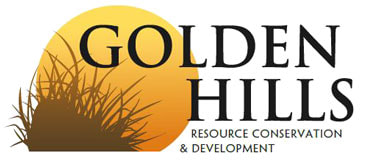






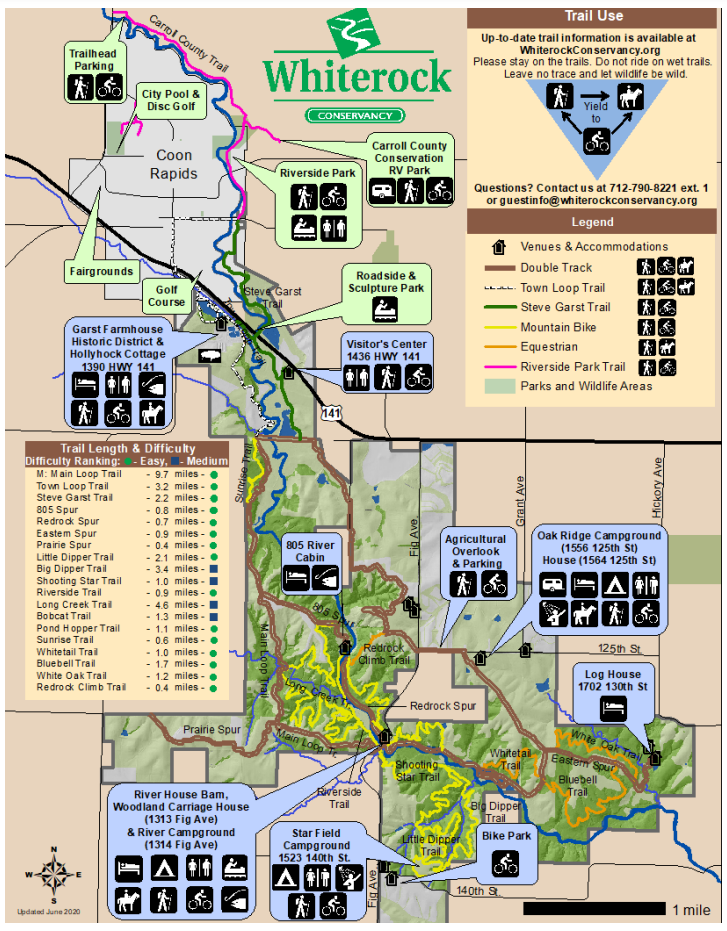

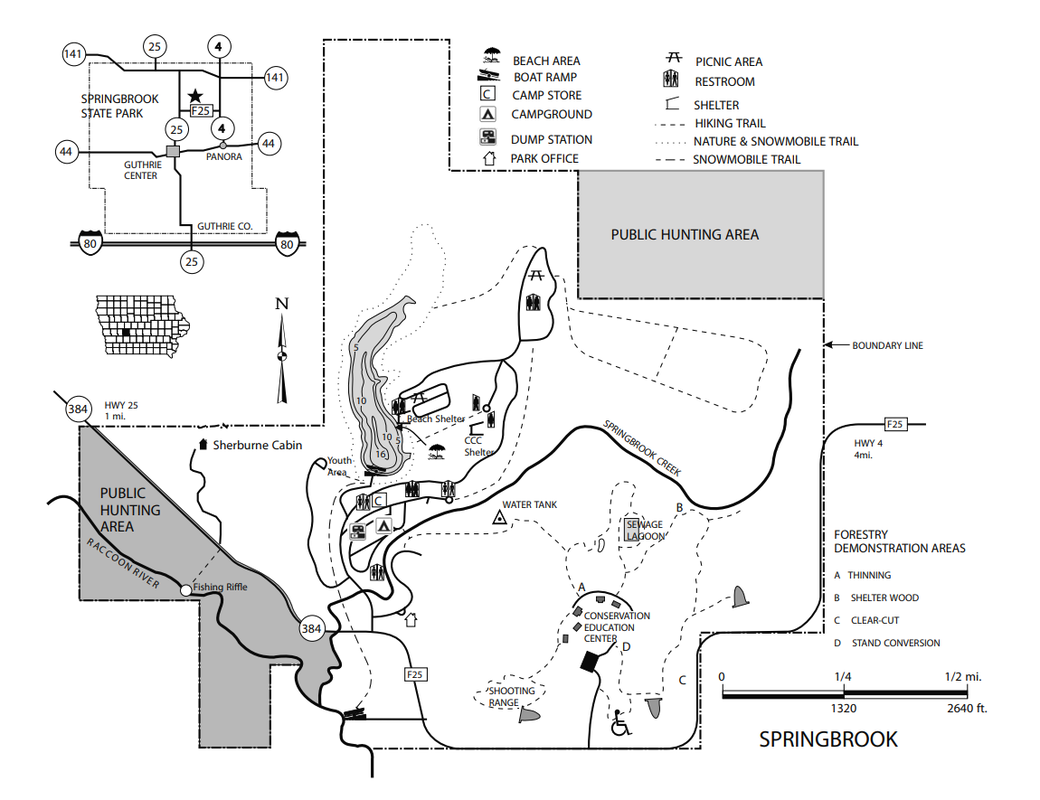





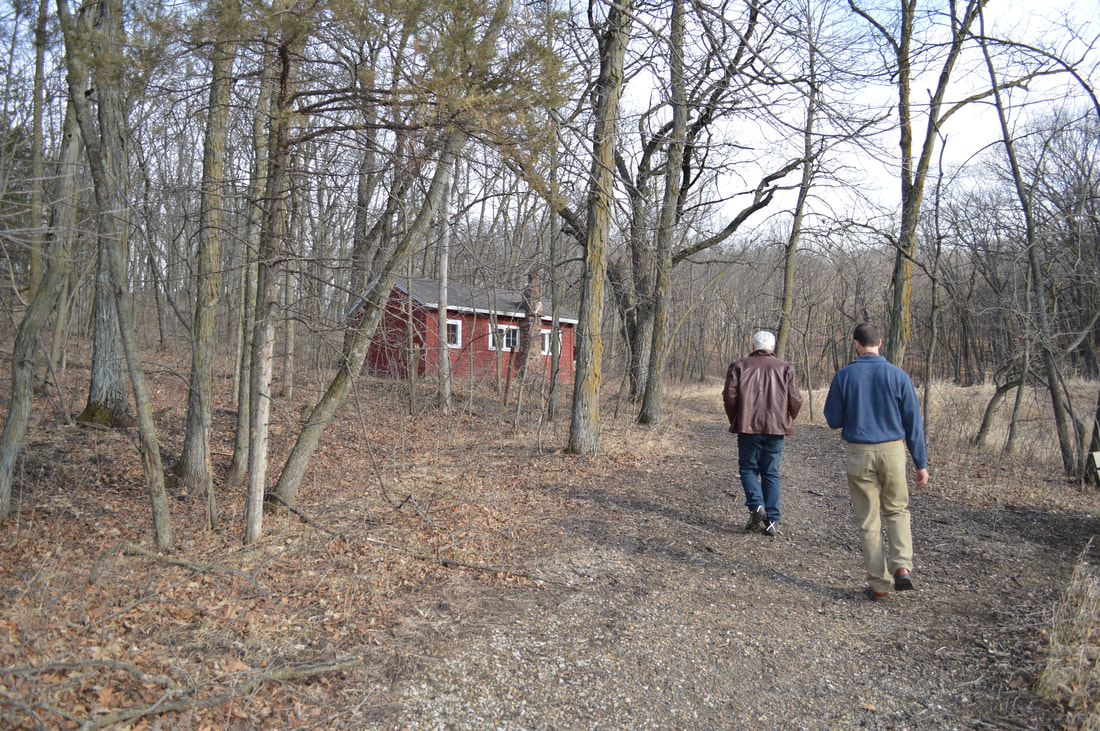
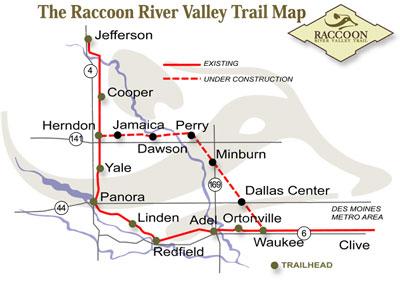








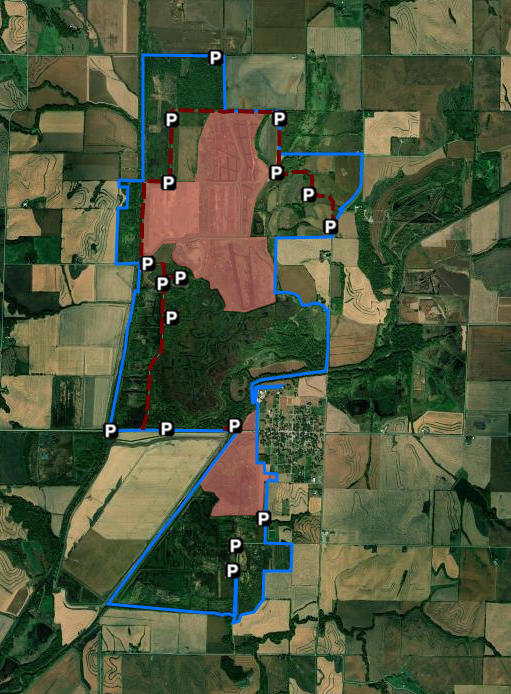


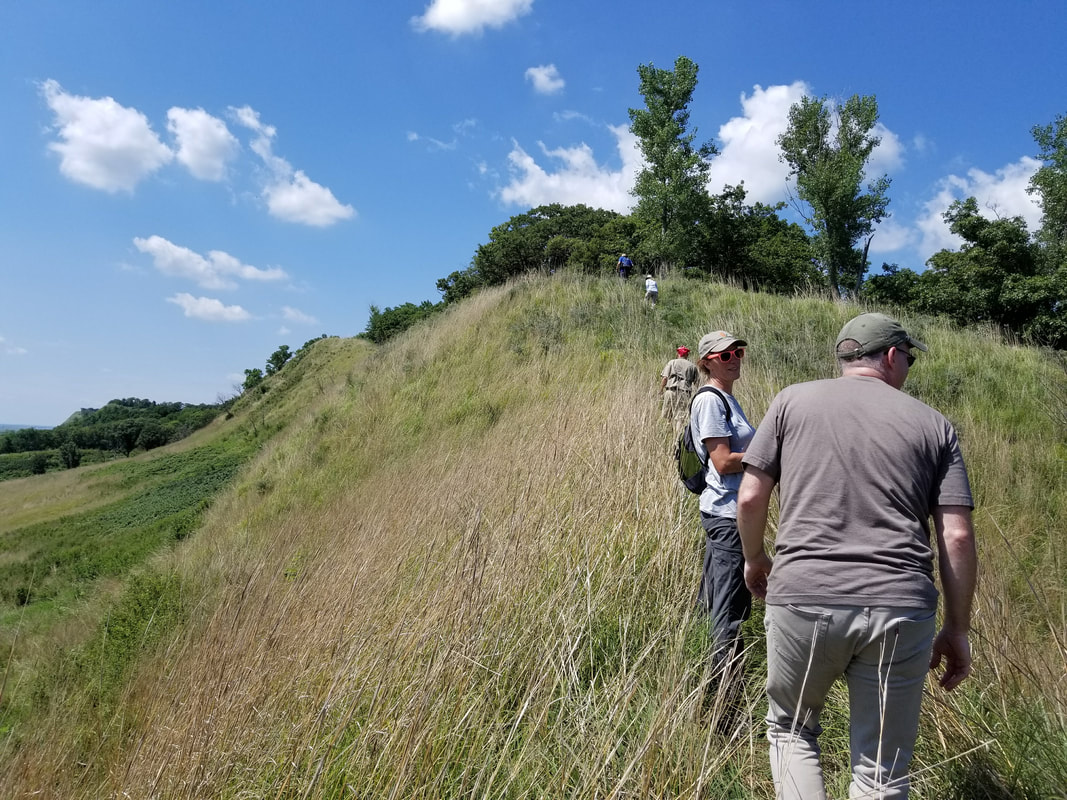

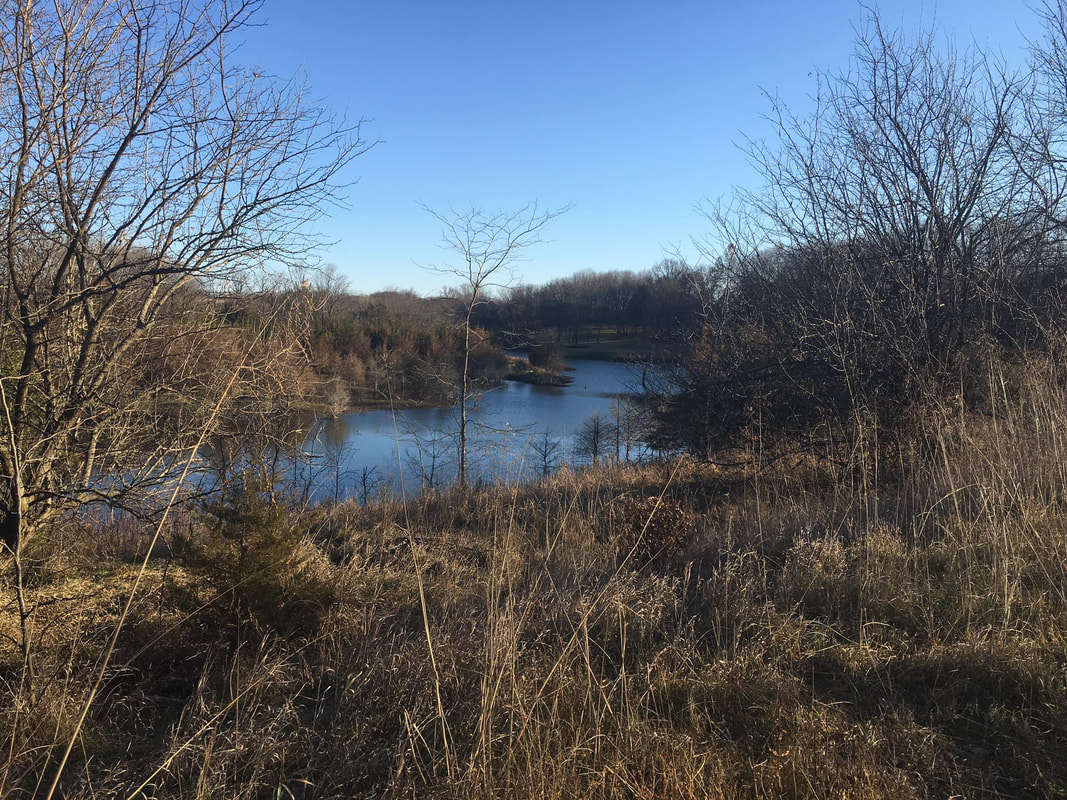







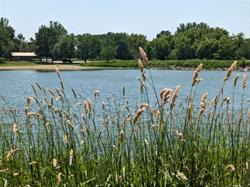
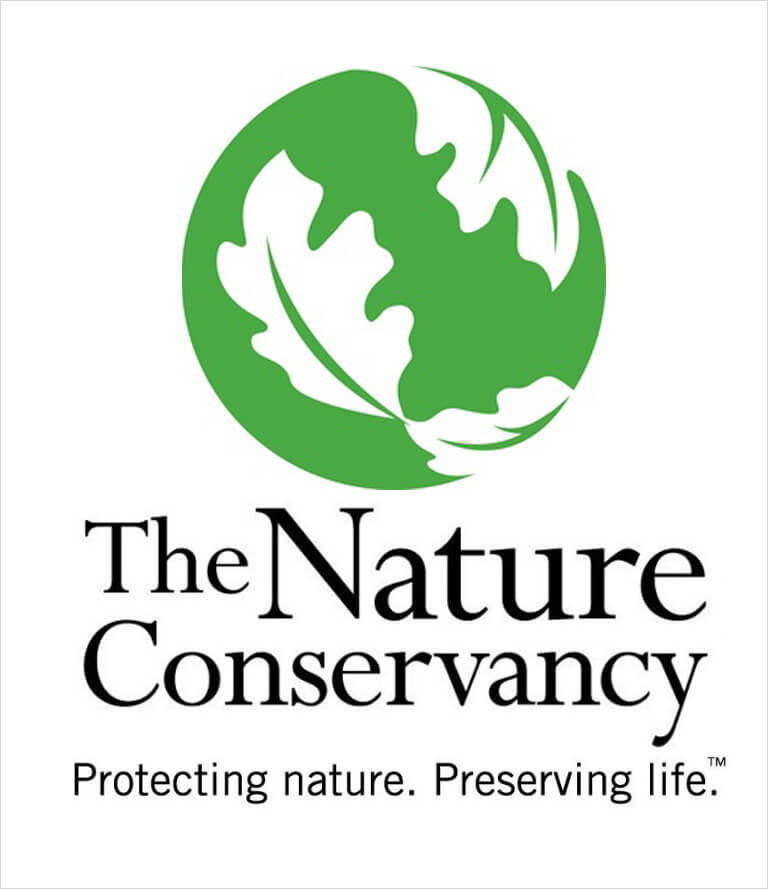

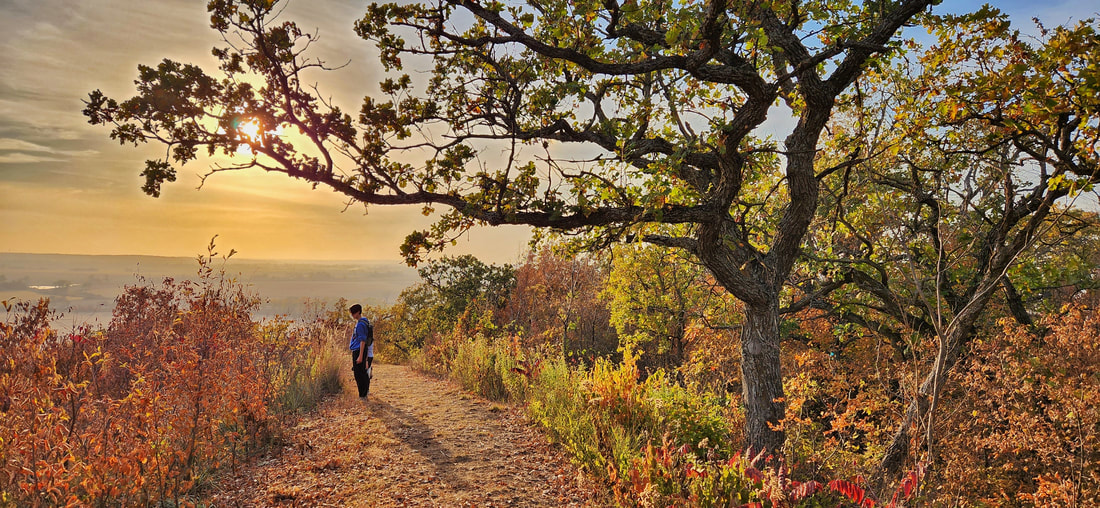






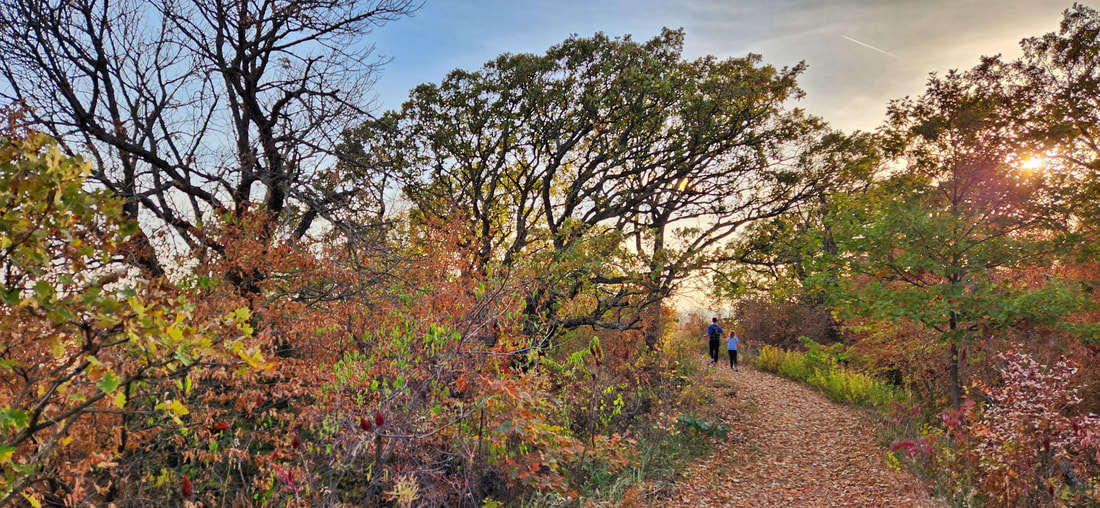















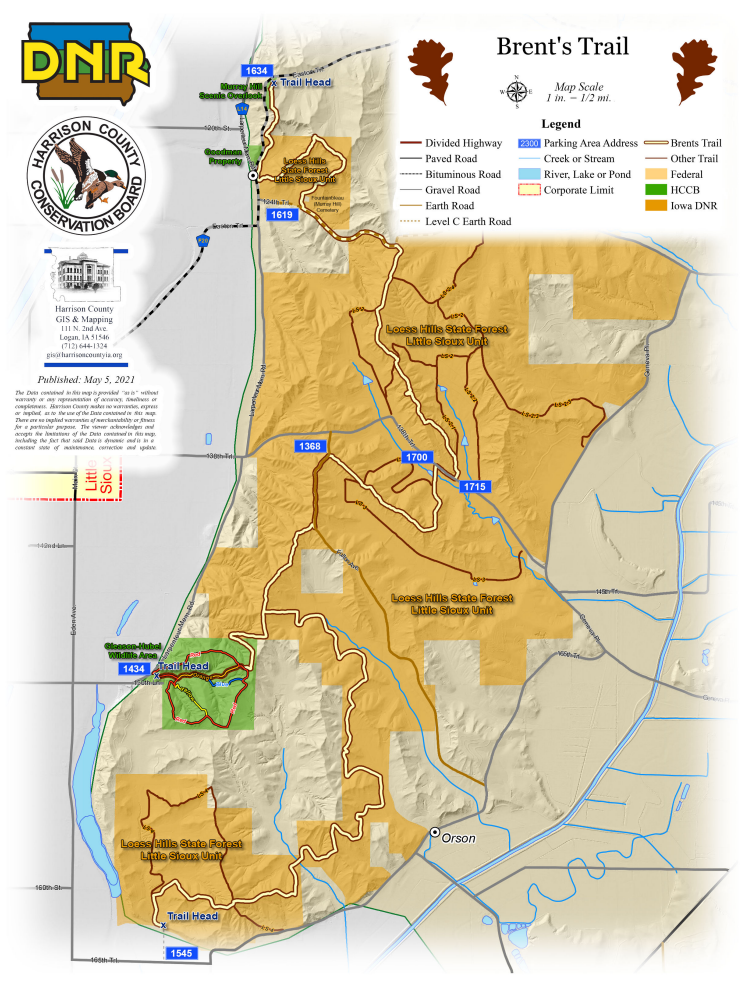








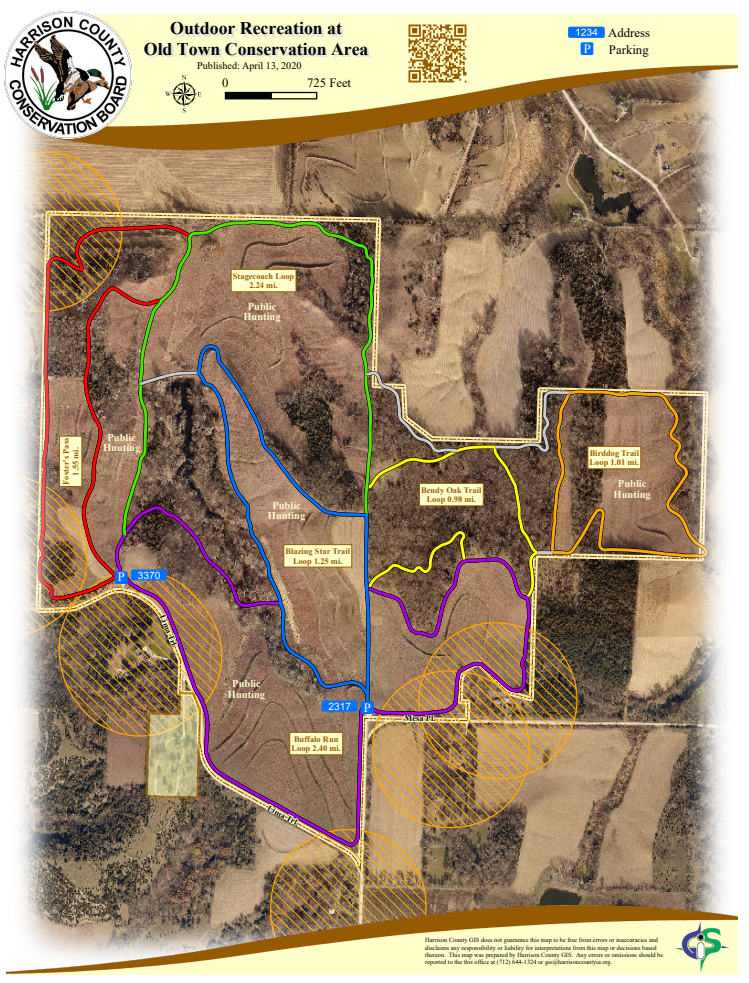








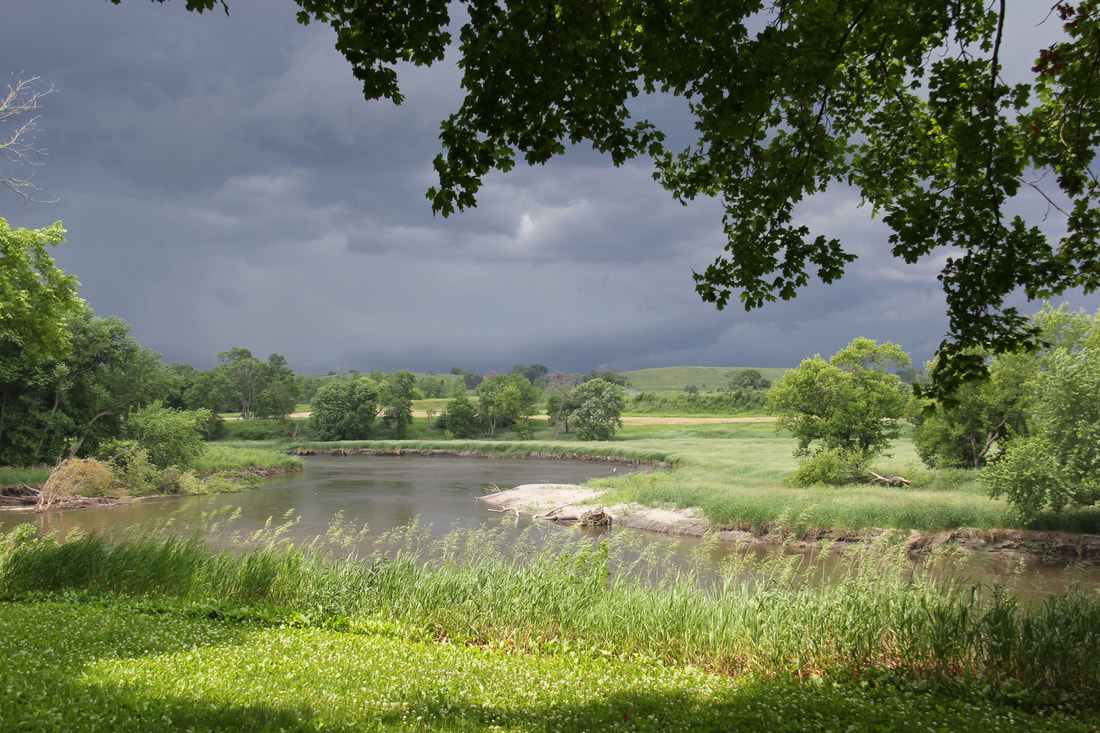
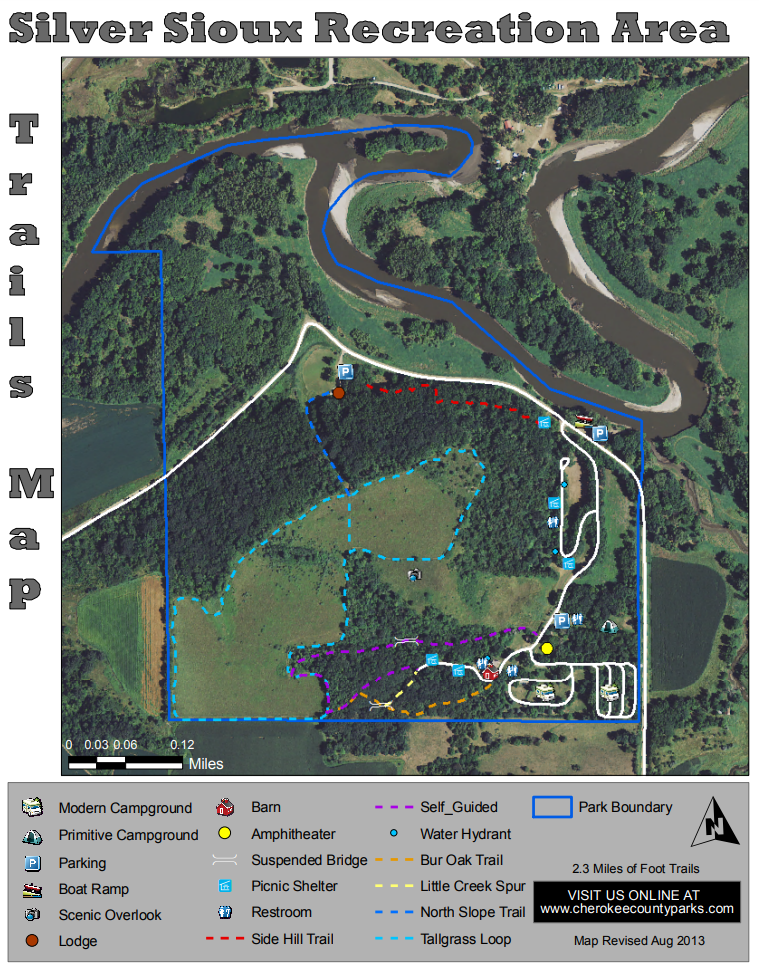




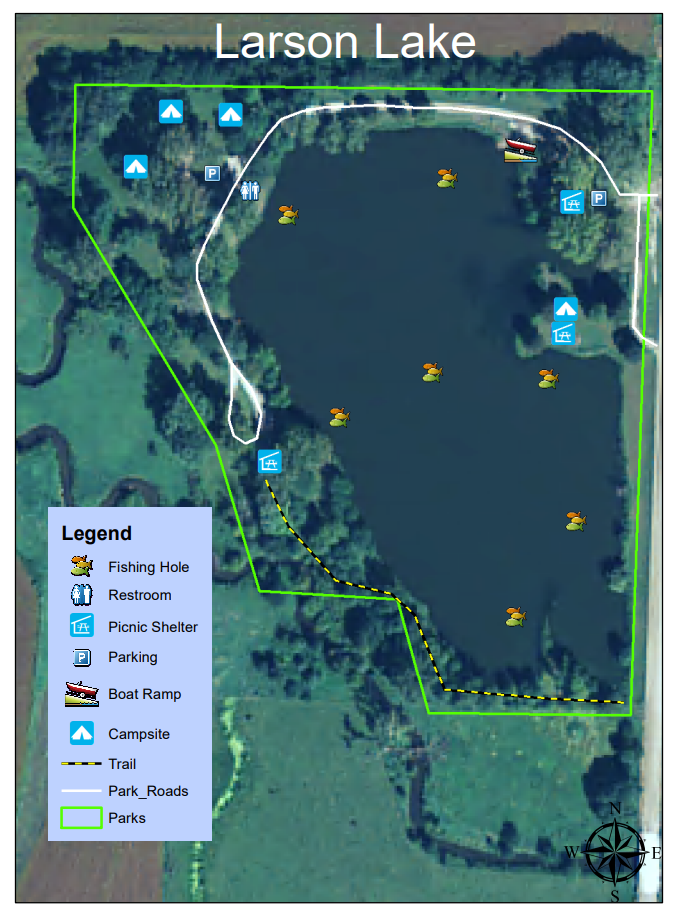

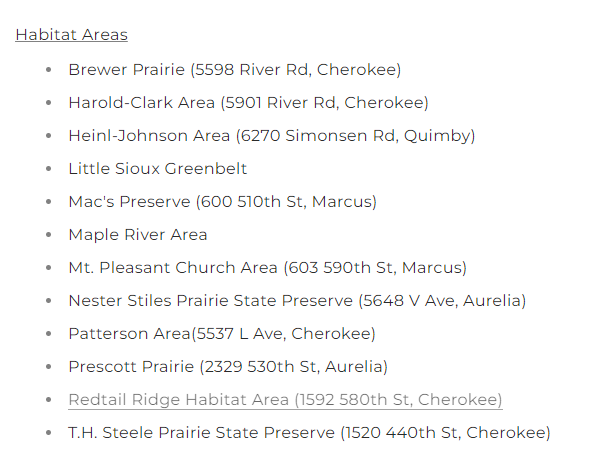


























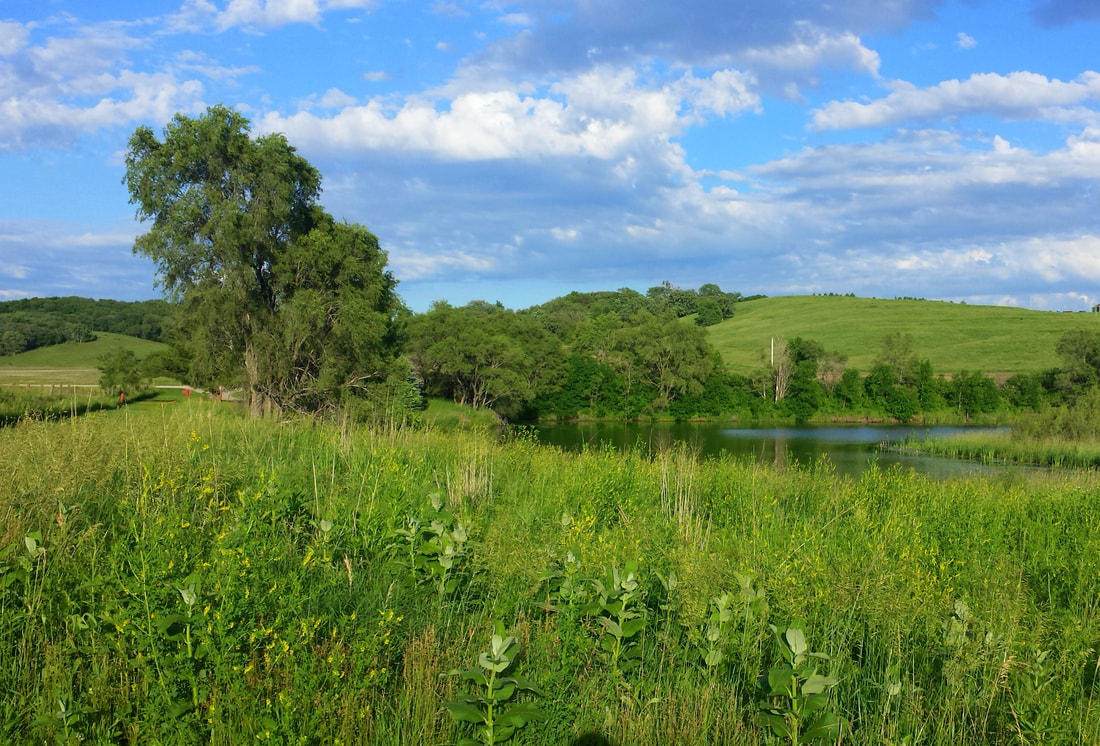





 RSS Feed
RSS Feed